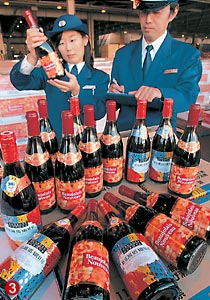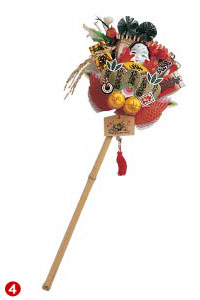 |
|
Shichi-go-san (7-5-3 Festival)
On this day, parents dress their children in formal traditional clothes, and take them to a shrine to celebrate their growth. Boys go when they are 5 years old, girls when they are 3 and 7. During the festival, the children are sure to be given chitose-ame ("thousand-year candies"). In the photo, the boy and girl hold bags containing the candies. The long, thin chitose-ame, which become even longer when pulled, are good-luck charms symbolizing the wish for a very long life. (Photo credit: Nakata Akira, Haga Library)
|
 |
|
Release of Beaujolais Nouveau wine
The year's stock of Beaujolais Nouveau wine from France is released worldwide at the stroke of midnight on the third Thursday in November. Because of the time difference, the release in Japan occurs earlier than anywhere else. Japan's Beaujolais imports in 2004 were much higher than in 2003, when the previous record was set. The wine's popularity continues to soar. The release triggers events around the country. (Photo credit: The Mainichi Newspapers Co.)
|
|
 |
2nd to 4th
Karatsu Kunchi Festival, at Karatsu Shrine, Karatsu, Saga Prefecture |
| |
|
 |
3rd
Bunka no Hi (Culture Day)
National holiday to encourage the flowering of culture, as well as the love of peace and freedom. |
| |
|
| |
Bunka Kunsho Juyo-shiki (Order of Culture Awards Ceremony)
The Order of Culture is presented at the Imperial Palace to people who have contributed greatly to the development of culture and science. |
| |
|
 |
8th
Hi-taki Festival, at Fushimi Inari Shrine, Kyoto |
| |
|
 |
12th to 18th, in 2005 (11th to 17th of the 10th month, in the old calendar)
Kami-ari Festival, at Izumo Shrine, Izumo, Shimane Prefecture
It is said that eight million gods live in Japan, and that they all go for their annual assembly to Izumo on the 10th day of the 10th month (old calendar, November in the modern calendar). The name of the festival, "Kami-ari," means "The gods are all present." Because the gods are all at Izumo, everywhere else in Japan has none, so the month of October is traditionally called Kannazuki (the month with no gods). |
| |
|
 |
Tori no Hi (Day of the Rooster)
Tori no Ichi (Day of the Rooster Fair)
In November, on the Day of the Rooster (one of the "12 branches" in the ancient Chinese calendar), a market festival is held at shrines in different parts of the country. The markets are said to bring prosperity and good luck. One item sold there is the decorated kumade rake (see photo ). ). |
| |
|
 |
2nd Sunday in November
Arashiyama Momiji (Autumn Colors) Festival, in Kyoto |
| |
|
 |
15th
Shichi-go-san (7-5-3 Festival)
(See photo ) ) |
| |
|
 |
3rd Thursday in November
Release of Beaujolais Nouveau wine
(See photo ) ) |
| |
|
 |
23rd
Kinro Kansha no Hi (Labor Day)
National holiday honoring the entire workforce and commemorating the nation's productivity. The concept of honoring labor began with the Niiname-sai harvest festival, which included a shrine ritual offering newly harvested rice to the gods.
|
| |
|
| |
|
|





